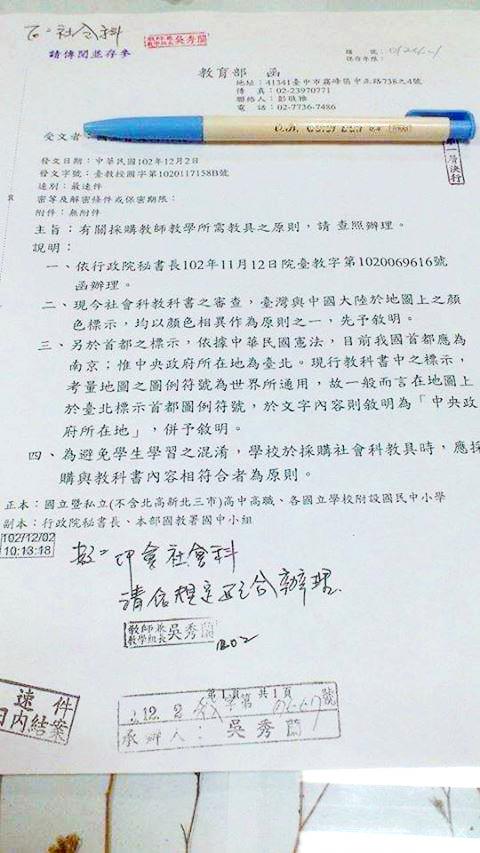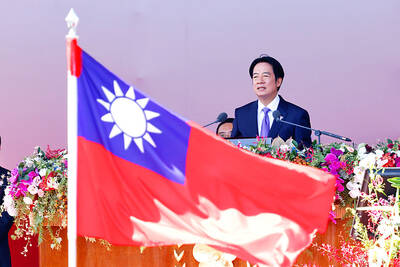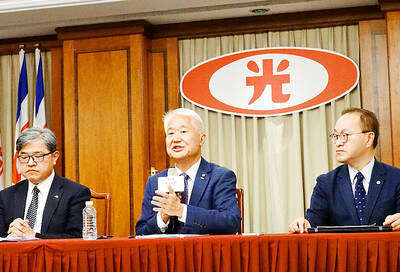A government document ordering schools’ procurement of teaching materials that mark Nanjing as the capital of the Republic of China (ROC) and Taipei as the current location of the central government indicated President Ma Ying-jeou’s (馬英九) administration’s persistent attempts to promote the links between Taiwan and China, as well as the administration’s misinterpretation of the Constitution, lawmakers and academics said yesterday.
A photograph posted by National Taipei University of Education professor Lee Hsiao-feng (李筱峰) on Facebook yesterday, which showed a Ministry of Education document issued on Monday to schools nationwide, went viral on the Internet.
“The document reflects the Ma administration’s ideology and its state of mind as a government-in-exile, which the majority of Taiwanese do not agree with. We should not be surprised because Ma has always tried to go against the trend,” Lee said.

Photo downloaded from Lee Hsiao-feng’s Facebook page
The professor said the photo was taken by one of his students, who is a teacher.
“Although Taiwan and mainland China have been marked with different colors in the textbook, Nanjing should be the ROC capital and Taipei is the current location of the central government, according to the ROC Constitution,” the document said.
Due to universal standards in map legends, Taipei would still be marked as the capital on the maps in teaching materials, but teachers are obligated to clearly explain the complexity of the situation to their students, the ministry said in the document, which was sent to high schools, vocational schools, junior-high schools and elementary schools across the country, except for those in Taipei, Greater Kaohsiung and New Taipei City (新北市).
Lee said that Ma has been trying to sinicize teaching materials, for example by insisting on referring to the period during which Taiwan was a Japanese colony as the “Japanese occupation period” in high-school textbooks.
Democratic Progressive Party (DPP) Legislator Lee Chun-yi (李俊俋) said the Constitution does not designate any city as the capital.
“Ma has been using the Constitution as a political tool to link Taiwan with China and to endorse his initiative of ‘one country, two regions.’ Everyone knows it’s nonsense and his interpretation of cross-strait relations is far from reality,” Lee Chun-yi said.
Under Ma’s leadership, government officials’ interpretation of the nation’s status has been “absurd,” he added, citing the example of Mongolian and Tibetan Commission Minister Tsai Yu-ling (蔡玉玲), who recently said that Mongolia remains ROC territory.
Ma has been inconsistent, DPP Legislator Chen Chi-mai (陳其邁) said, as he said he wanted to “make Taipei a world-class capital city” when he served as Taipei mayor.
The DPP administration between 2000 and 2008 reiterated that Taipei is the ROC capital, Chen said.
“Judging by a series of policy changes during the Ma administration, it has been engaging in a ‘de-Taiwanization campaign’ in an attempt to brainwash students and to force Ma’s ‘one China’ ideology upon young people,” Chen said.
Later yesterday, the ministry official in charge of the matter said he would take full administrative responsibility for not making the ministry’s intent clear in the document.
The head of the ministry’s K-12 Education Administration Division, Chiu Chien-kuo (邱乾國), said that during the Period of Political Tutelage (訓政時期), it had been mentioned that the capital of the nation was Nanjing, but there was no such mention in the Constitution after its ratification.
Since the implementation of the Act Governing Principles for Editing Geographical Educational Texts (地理教科書編審原則) in 1997, the guiding principle for all maps in geographical textbooks was that Taipei was to be marked as the capital with a label stating: “Location of Central Government,” Chiu said.
The part in the ministry’s document mentioning Nanjing did not provide a detailed explanation, for which he extended his apology, saying he was willing to assume responsibility for any administrative lapse, he added.
Additional reporting by staff writer

People can preregister to receive their NT$10,000 (US$325) cash distributed from the central government on Nov. 5 after President William Lai (賴清德) yesterday signed the Special Budget for Strengthening Economic, Social and National Security Resilience, the Executive Yuan told a news conference last night. The special budget, passed by the Legislative Yuan on Friday last week with a cash handout budget of NT$236 billion, was officially submitted to the Executive Yuan and the Presidential Office yesterday afternoon. People can register through the official Web site at https://10000.gov.tw to have the funds deposited into their bank accounts, withdraw the funds at automated teller

PEACE AND STABILITY: Maintaining the cross-strait ‘status quo’ has long been the government’s position, the Ministry of Foreign Affairs said Taiwan is committed to maintaining the cross-strait “status quo” and seeks no escalation of tensions, the Ministry of Foreign Affairs (MOFA) said yesterday, rebutting a Time magazine opinion piece that described President William Lai (賴清德) as a “reckless leader.” The article, titled “The US Must Beware of Taiwan’s Reckless Leader,” was written by Lyle Goldstein, director of the Asia Program at the Washington-based Defense Priorities think tank. Goldstein wrote that Taiwan is “the world’s most dangerous flashpoint” amid ongoing conflicts in the Middle East and Russia’s invasion of Ukraine. He said that the situation in the Taiwan Strait has become less stable

CONCESSION: A Shin Kong official said that the firm was ‘willing to contribute’ to the nation, as the move would enable Nvidia Crop to build its headquarters in Taiwan Shin Kong Life Insurance Co (新光人壽) yesterday said it would relinquish land-use rights, or known as surface rights, for two plots in Taipei’s Beitou District (北投), paving the way for Nvidia Corp to expand its office footprint in Taiwan. The insurer said it made the decision “in the interest of the nation’s greater good” and would not seek compensation from taxpayers for potential future losses, calling the move a gesture to resolve a months-long impasse among the insurer, the Taipei City Government and the US chip giant. “The decision was made on the condition that the Taipei City Government reimburses the related

FRESH LOOK: A committee would gather expert and public input on the themes and visual motifs that would appear on the notes, the central bank governor said The central bank has launched a comprehensive redesign of New Taiwan dollar banknotes to enhance anti-counterfeiting measures, improve accessibility and align the bills with global sustainability standards, Governor Yang Chin-long (楊金龍) told a meeting of the legislature’s Finance Committee yesterday. The overhaul would affect all five denominations — NT$100, NT$200, NT$500, NT$1,000 and NT$2,000 notes — but not coins, Yang said. It would be the first major update to the banknotes in 24 years, as the current series, introduced in 2001, has remained in circulation amid rapid advances in printing technology and security standards. “Updating the notes is essential to safeguard the integrity